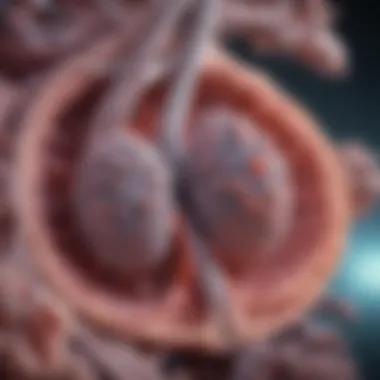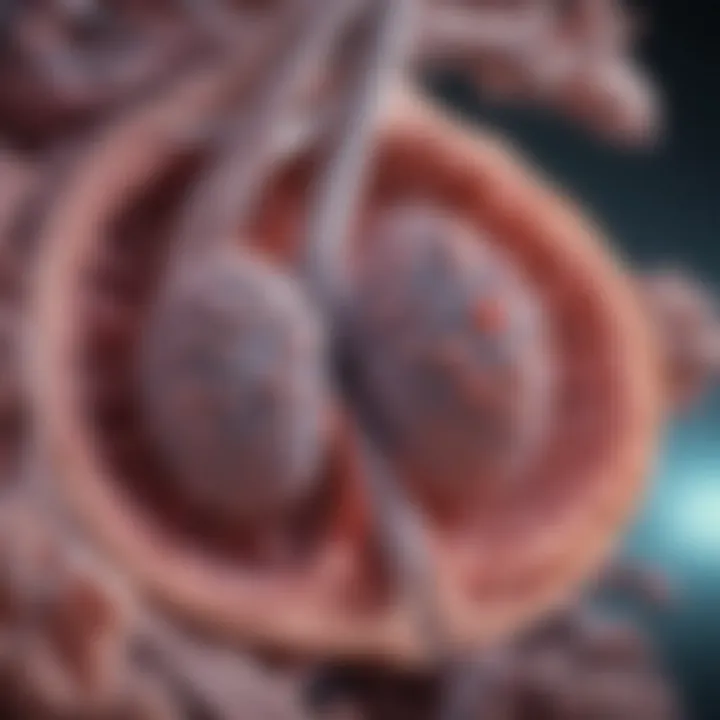Hypermetabolic Pulmonary Nodules: Causes and Treatments


Intro
Hypermetabolic pulmonary nodules present a complex area of study within the field of medical diagnostics and treatment. Recognizing these nodules is essential, as they can signify a range of underlying conditions. Understanding the nature of hypermetabolic activity can help in differentiating benign conditions from malignant processes. With the advancement in imaging techniques, the interpretation of hypermetabolic nodules has become more nuanced, leading to significant implications for patient management.
This article will explore different aspects of hypermetabolic pulmonary nodules, including their definition, potential causes, and diagnostic methodologies. Healthcare professionals often encounter these findings in routine imaging, which can create challenges in diagnosis. Therefore, a thorough understanding is necessary to enhance clinical practice and research initiatives.
Key Findings
Hypermetabolic pulmonary nodules are not a singular entity but arise from various conditions. Identifying the specific reason behind hypermetabolic activity is critical for effective treatment. The following key findings summarize the current understanding of hypermetabolic pulmonary nodules:
- Classification of Nodules: Hypermetabolic nodules can be classified based on their metabolic activity. Techniques like positron emission tomography (PET) are instrumental in determining the level of metabolism.
- Causes: These nodules can stem from malignancies, infections, inflammatory conditions, or even benign tumors. Understanding the cause is crucial for determining the treatment strategy.
- Diagnostic Complexity: The presence of hypermetabolic activity does not automatically indicate malignancy. Several benign processes can cause hypermetabolic changes, complicating the diagnostic process.
"A thorough diagnostic approach is crucial for accurate management of hypermetabolic nodules."
Major Results
Research indicates that hypermetabolic pulmonary nodules require careful evaluation to determine clinical significance. Major results from studies demonstrate various outcomes based on the underlying conditions:
- In patients with a known history of cancer, hypermetabolic nodules often indicate metastatic disease.
- In contrast, isolated hypermetabolic nodules in immunocompromised patients might suggest infections like tuberculosis.
Understanding these distinctions leads to more tailored and effective treatment decisions.
Discussion of Findings
The findings collectively emphasize the importance of a structured diagnostic approach. As healthcare providers confront hypermetabolic nodules, they must consider the full spectrum of possible etiologies. Integration of clinical history, imaging findings, and laboratory tests is key to deciphering the clinical picture. The complexity of diagnostics reflects the diverse nature of pulmonary lesions and the necessity for ongoing research in this field.
Understanding Hypermetabolic Pulmonary Nodules
Hypermetabolic pulmonary nodules are vital in medical diagnostics and treatment planning. Understanding their nature can significantly affect patient outcomes. This section discusses the definition, characteristics, and underlying mechanisms of these nodules, which is essential for healthcare professionals. Recognizing the implications of hypermetabolic activity aids in accurate diagnosis and tailored management strategies.
Definition and Characteristics
Hypermetabolic pulmonary nodules refer to areas of increased metabolic activity in the lung, usually detected via imaging techniques. These nodules may appear on scans as areas of increased tracer uptake, indicating a higher level of cellular activity. Understanding the term "hypermetabolic" is crucial; it signifies not only the presence of nodules but also hints at potential underlying conditions.
Such nodules can vary in size, shape, and density, which are essential factors in assessing their clinical significance. While some nodules are benign, others may indicate malignancy. Therefore, healthcare providers must take a nuanced approach when interpreting imaging results. The characteristics of these nodules are typically assessed through various parameters, including:
- Size: Larger nodules are more concerning for malignancy.
- Shape: Irregular margins may suggest a higher likelihood of cancer.
- Density: Different densities on scans often correlate with specific types of conditions.
In clinical practice, distinguishing between benign and malignant nodules based on characteristics is paramount. This also involves considering patient risk factors, such as smoking history and family predisposition to cancers.
The presence of hypermetabolic activity significantly complicates the clinical picture but provides important clues for diagnosis and management.
Pathophysiology
The pathophysiology of hypermetabolic pulmonary nodules encompasses diverse biological processes. These processes depend on the underlying cause of the increased metabolic uptake noted on imaging studies. Generally, hypermetabolic activity can arise from several mechanisms:
- Malignant growth: Cancer cells often exhibit increased metabolic activity as they grow and proliferate rapidly. This results in the accumulation of metabolic byproducts, detectable through various imaging techniques.
- Inflammatory processes: Conditions such as infections or autoimmune diseases can lead to hypermetabolism. The immune response generates elevated metabolic rates as cells increase energy production to combat pathogens or control inflammation.
- Reparative mechanisms: After injury to lung tissue, fibroblasts and other cells may increase their metabolic rate to repair damaged areas, resulting in hypermetabolic nodules.
- Granulomatous disease: Diseases like sarcoidosis or tuberculosis can also cause hypermetabolic activity in the lungs. These conditions involve the formation of granulomas, which inherently have higher metabolic rates due to ongoing inflammatory activity.
Thus, understanding the pathophysiology behind hypermetabolic pulmoanry nodules is critical, as it provides insights into their possible origins and helps prioritize diagnostic evaluations.
Imaging Techniques in Diagnosing Hypermetabolic Nodules
Imaging plays a crucial role in the evaluation of hypermetabolic pulmonary nodules. Accurate diagnosis relies heavily on the use of advanced imaging techniques. These methods help distinguish between benign and malignant nodules and assess the physiological activity of lung lesions. The findings from imaging studies can influence management decisions, which may include monitoring, further investigation, or immediate intervention.


Each imaging modality offers unique benefits and limitations, making it essential to understand their capabilities when diagnosing hypermetabolic nodules. The integration of different imaging techniques can provide a more comprehensive view of the nodules, leading to better clinical outcomes.
Positron Emission Tomography (PET)
Positron Emission Tomography is a highly sensitive imaging technique used to assess metabolic activity in tissues. PET utilizes radioactive tracers, commonly fluorodeoxyglucose (FDG), which is taken up by actively metabolizing cells. This property allows for the identification of hypermetabolic nodules, which may indicate malignancy.
One significant advantage of PET is its ability to evaluate the metabolic activity of nodules, providing insights on whether nodules are benign or malignant. The high sensitivity of PET can aid in detecting lesions that may not be visible on conventional imaging. However, it is important to note that some benign conditions, such as infections and inflammatory diseases, can also exhibit hypermetabolic activity, which complicates interpretation.
Computed Tomography (CT)
Computed Tomography is another essential imaging modality used to investigate pulmonary nodules. CT scans provide detailed cross-sectional images of lung anatomy, allowing radiologists to evaluate the size, shape, and characteristics of nodules. This imaging technique can help in risk stratification and management planning.
CT is particularly useful in assessing the morphology of nodules, as certain features may suggest malignancy. For instance, irregular borders, spiculated edges, and rapid growth can be indicative of cancer. Moreover, high-resolution CT can visualize small nodules, which is crucial for early detection. However, CT does not provide definitive information about metabolic activity, thus limiting its effectiveness in differentiating between benign and malignant lesions without further testing.
Magnetic Resonance Imaging (MRI)
Magnetic Resonance Imaging is less commonly used for lung nodules compared to PET and CT due to limited sensitivity for certain lesions. However, MRI can be beneficial in specific scenarios, particularly when evaluating soft tissue characteristics of pulmonary nodules or when there is a need to assess surrounding structures such as the mediastinum.
MRI's primary advantage lies in its non-ionizing radiation aspect, making it an alternative for patients who require multiple scans. Certain sequences can depict vascularity and tissue composition, which may provide helpful information in diagnosing complex cases. However, the role of MRI in the routine evaluation of hypermetabolic pulmonary nodules remains limited when compared to PET and CT.
Causes of Hypermetabolic Activity in Pulmonary Nodules
Understanding the causes of hypermetabolic activity in pulmonary nodules is essential in unraveling the complexities associated with pulmonary health. Recognizing the underlying reasons can lead to timely intervention and appropriate management. Hypermetabolic activity often indicates an increased metabolic rate, which can be triggered by various pathologies. This section delves into the primary categories of causes, discussing malignant processes, benign conditions, infectious diseases, and inflammatory conditions.
Malignant Processes
Malignant processes are one of the most critical considerations when evaluating hypermetabolic pulmonary nodules. This category primarily includes different types of cancers. When hypermetabolic activity is detected, it may suggest the presence of malignancies such as lung cancer, which can arise from epithelial cells. Other malignancies, like metastatic lesions from distant sites, can also manifest in pulmonary nodules. Tumors often exhibit elevated glucose metabolism, seen in imaging tests such as PET scans.
The significance of identifying malignant processes cannot be understated. Early detection often correlates with better prognosis and effective treatment options. It is essential not only for the immediate management but also for long-term survival. Furthermore, understanding the specific type of malignancy aids in tailoring treatment plans and enhances personalized medicine approaches.
Benign Conditions
Not all hypermetabolic activity in pulmonary nodules indicates malignancy. Benign conditions can also cause increased metabolic rates. For instance, hamartomas are a type of benign tumor that can present as nodules, demonstrating hypermetabolic function. Other benign processes include granulomas formed due to conditions like sarcoidosis.
These nodules can confuse clinicians due to their similarities to malignant nodules on imaging. Recognizing benign conditions allows for more conservative management strategies, thereby reducing unnecessary interventions such as biopsies or surgeries. This understanding fosters a balanced approach when interpreting imaging results and influences patient management significantly.
Infectious Diseases
Infectious diseases account for numerous cases of hypermetabolic pulmonary nodules. Conditions such as tuberculosis, fungal infections, and viral infections can result in the formation of nodules with heightened metabolic activity. Tuberculosis, in particular, often presents with granulomatous inflammation, leading to increased uptake of radiotracers during imaging.
The clinical implication here is substantial. Timely diagnosis and rapid initiation of appropriate antimicrobial therapy can drastically affect outcomes. Understanding the infectious etiology associated with hypermetabolic activity aids in developing proper treatment regimens and can prevent the spread of infection, particularly in cases with contagious pathogens.
Inflammatory Conditions
Inflammatory conditions also play a notable role in causing hypermetabolic activity in pulmonary nodules. Conditions such as autoimmune disorders, chronic obstructive pulmonary disease (COPD), and interstitial lung diseases can contribute to heightened metabolic responses. Inflammation often results in increased cellular activity and metabolic demands, which imaging techniques can detect.
Identifying these inflammatory causes is vital, as they often require a different therapeutic approach compared to malignant or infectious causes. Managing inflammation through immunosuppressive therapies or other targeted treatments can lead to significant improvements in patient outcomes. Awareness of these conditions can help clinicians differentiate between these and more serious possibilities, ensuring a judicious approach to managing patient care.
Differentiating Hypermetabolic Pulmonary Nodules
Differentiating hypermetabolic pulmonary nodules is crucial for assessing patient outcomes and determining appropriate treatment. The ability to distinguish between malignant and benign nodules can significantly impact management strategies and patient monitoring. This subject is particularly important because hypermetabolic activity often raises suspicion for various underlying conditions, including cancer. Recognizing the characteristics that define each type of nodule aids in narrowing down a diagnosis, leading to more effective clinical interventions.
Characteristics of Malignant Nodules


Malignant pulmonary nodules typically show distinct characteristics on imaging studies. These nodules often appear irregularly shaped, with spiculated or lobulated margins. A greater size, especially over 1 cm, correlates with a higher likelihood of malignancy. Additionally, they may exhibit increased metabolic activity seen on Positron Emission Tomography (PET) scans, indicated by a higher standardized uptake value (SUV). Other factors contributing to the suspicion of malignant nodules include:
- Growth rate: Rapid enlargement, observed through serial imaging, raises concern.
- Patient demographics: Age, smoking history, and family cancer history.
- Associated findings: Presence of mediastinal lymphadenopathy or pleural effusion can indicate advanced disease.
Understanding these features enables healthcare providers to prioritize further evaluation and intervention, potentially improving prognosis for patients with malignant conditions.
Identifying Benign Nodules
Benign nodules present a different profile that is key to differentiate from malignant ones. These nodules often appear smooth and well-defined with regular borders on imaging. Common benign causes include granulomas, hamartomas, and infections such as histoplasmosis or tuberculosis. Their characteristics include:
- Calcium content: Presence of calcification in a specific pattern (e.g., central, laminated) generally suggests a benign process.
- Stable size: Benign nodules usually do not change significantly over time, especially in patients without risk factors for malignancy.
- Symptom assessment: Many benign nodules are asymptomatic and discovered incidentally during imaging for unrelated issues.
By identifying these benign features, clinicians can avoid unnecessary invasive procedures while ensuring appropriate follow-up and patient reassurance.
Role of Biopsy in Diagnosis
The role of biopsy in the diagnosis of hypermetabolic pulmonary nodules cannot be understated. In cases where nodules cannot be deemed clearly malignant or benign based on imaging alone, a biopsy provides essential tissue diagnosis. There are several types of biopsies:
- Fine needle aspiration (FNA): Often used for easily accessible nodules.
- Core needle biopsy: Provides more tissue, increasing diagnostic yield.
- Surgical biopsy: Considered when imaging suggests malignancy yet non-invasive approaches are inconclusive.
Biopsy also enables evaluation of specific histological subtypes, allowing tailored treatment plans. It plays a critical role in determining treatment pathways, whether surgical, chemotherapy, or observation.
In summary, differentiating hypermetabolic pulmonary nodules is essential for accurate diagnosis and effective management. Understanding the characteristics of malignant versus benign nodules and utilizing biopsies wisely can lead to substantial improvements in patient care.
Clinical Implications of Hypermetabolic Pulmonary Nodules
Hypermetabolic pulmonary nodules present significant clinical implications. Their detection raises important considerations regarding diagnosis, management, and long-term monitoring. Understanding these implications is crucial for healthcare providers, as it allows for a more tailored approach to patient care, improving outcomes. Notably, the hypermetabolic status of a nodule often indicates an increased likelihood of malignancy, which necessitates immediate attention and potentially aggressive interventions. This section will explore the various facets of management strategies, monitoring protocols, and the importance of referral to specialists.
Management Strategies
Management strategies for hypermetabolic pulmonary nodules should be comprehensive and individualized based on the patient's clinical context. These strategies encompass a variety of approaches, including:
- Initial Evaluation: A detailed history and physical examination are essential to assess risk factors and symptoms.
- Further Imaging: Depending on initial findings, follow-up imaging with a CT scan may be warranted to refine assessment.
- Biopsy Procedures: When indicated, tissue samples can be obtained to determine malignancy. Techniques like bronchoscopy or CT-guided fine-needle aspiration are commonly employed.
- Treatment Decisions: Upon diagnosis, treatment plans must align with the underlying condition, ranging from surgical resection for malignant nodules to observation for benign cases.
It is vital that healthcare providers remain informed about evolving guidelines and protocols surrounding these strategies, as advancements in research may influence practice patterns moving forward.
Patient Monitoring Protocols
Effective patient monitoring protocols are essential for those with identified hypermetabolic nodules. Regular follow-up allows for the detection of any changes in nodule characteristics. Key components of monitoring protocols include:
- Scheduled Imaging: Regular follow-up scans (e.g., CT or PET) to observe for growth or changes in metabolic activity.
- Symptom Tracking: Active monitoring of symptoms such as cough, weight loss, and hemoptysis, which may indicate progression.
- Assessment of Risk Factors: Continuous evaluation of any changes in the patient’s risk profile, including smoking status or exposure to carcinogens.
Institutional protocols may vary, but consistency in monitoring is crucial to optimizing patient outcomes and making timely treatment decisions.
Referral to Specialists
Referral to specialists can be critical in managing hypermetabolic pulmonary nodules, particularly in complex cases. Specialists bring advanced knowledge and skills to handle the various aspects of patient care. Relevant specialists may include:
- Pulmonologists: They play a key role in initially assessing lung nodules and managing any respiratory symptoms.
- Oncologists: When malignancy is suspected, oncologists provide expertise in managing cancer treatment and palliative care options.
- Thoracic Surgeons: In cases where surgical intervention is necessary, thoracic surgeons are essential for executing procedures safely and effectively.
Collaboration between primary care physicians and specialists fosters a multidisciplinary approach, ensuring that patients receive comprehensive care tailored to their specific needs. Effective communication among all parties involved enhances the decision-making process and improves the overall management of hypermetabolic pulmonary nodules.
Current Research Trends


The landscape of medical research is always advancing. This is also true for hypermetabolic pulmonary nodules. Understanding current research trends is essential for professionals who deal with such cases. The focus on hypermetabolic activity directly impacts diagnosis and treatment options. Researchers are working on enhancing imaging technologies and identifying biomarkers that can aid in decision-making.
Advancements in Imaging Technology
Recent advancements in imaging technology play a crucial role in the evaluation of hypermetabolic pulmonary nodules. Specifically, developments in hybrid imaging, such as PET/CT, allow for better localization and characterization of nodules. The combination of functional and anatomical imaging offers insights that single imaging modalities often miss.
Additionally, the use of artificial intelligence is gaining ground in image acquisition and interpretation. AI-driven algorithms analyze imaging data at a speed and accuracy levels beyond human capability. This can potentially reduce the time needed to evaluate nodules, leading to quicker clinical decisions.
Furthermore, new contrast agents are being developed, which may improve the detection of metabolic activity in nodules. These technological leaps pave the way for higher sensitivity in identifying suspicious lesions. As a result, this may lead to earlier interventions and improved patient outcomes.
Investigations into Biomarkers
The exploration of biomarkers is another exciting frontier in the study of hypermetabolic pulmonary nodules. Biomarkers can provide additional information beyond imaging results. They can help distinguish between malignant and benign nodules by revealing underlying biological processes.
Researchers are actively investigating various biomarkers, including genetic, proteomic, and metabolomic indicators. For example, specific gene mutations have been linked to certain types of lung cancer. Understanding these markers can guide physicians in selecting the most appropriate treatment options.
Additionally, serum biomarkers are also under investigation. These may serve as non-invasive tools to monitor disease progression or response to therapy effectively.
The integration of imaging technology and biomarkers is essential for a more comprehensive approach to treatment and management.
By combining the insights gained from advanced imaging techniques and the molecular insights from biomarkers, healthcare providers can make more informed decisions concerning patient care. This level of detail in research not only enhances diagnostic accuracy but also aims to improve clinical outcomes.
Continuing research in these areas is pivotal as it shapes future clinical practices regarding hypermetabolic pulmonary nodules. Understanding how these trends evolve will significantly influence how practitioners approach diagnosis and treatment.
Future Directions in Research
Understanding hypermetabolic pulmonary nodules reveals complexities that require ongoing investigation. The future directions in this research area are critical to enhance diagnostic accuracy and improve patient outcomes. Insights gained from these studies can lead to the development of innovative strategies in both diagnosis and management, which may significantly shift the clinical approach to these nodules. Furthermore, identifying potential biomarkers and advancing imaging technologies can provide clinicians with tools for better decision-making.
Innovative Diagnostic Approaches
The continuous evolution of diagnostic methodologies is vital in tackling hypermetabolic pulmonary nodules. Among the potential innovations, integration of artificial intelligence (AI) and machine learning algorithms into imaging analysis shows promise. These technologies can help interpret data more efficiently, allowing for rapid assessment of nodule characteristics. By leveraging vast datasets, AI can assist in distinguishing between benign and malignant nodules with higher accuracy than traditional methods.
Moreover, the development of liquid biopsies is another promising direction. Liquid biopsies analyze circulating tumor DNA in blood samples, which can aid in identifying cancer presence or progression without the need for invasive procedures. This technique provides a less risky alternative for patients, potentially leading to quicker and more efficient diagnostics.
"Advancements like AI and liquid biopsies may redefine the way we approach diagnosis of hypermetabolic pulmonary nodules, offering more accurate and less invasive options for assessment."
Improving Clinical Outcomes
Improving clinical outcomes for patients with hypermetabolic pulmonary nodules is a multi-faceted endeavor. Future research should include larger cohort studies to identify patterns in nodule behavior and the effectiveness of different management strategies. Analyzing real-world data can lead to a better understanding of how to tailor treatment plans according to individual patient profiles.
Effective communication among healthcare providers, patients, and caregivers is essential for optimizing management strategies. Developing standardized protocols for monitoring nodules over time can ensure consistency in care. This includes determining the right intervals for follow-up imaging studies based on initial nodule characteristics.
Additionally, the identification of predictive biomarkers can revolutionize treatment decisions. If specific markers associated with nodules can be defined, clinicians may be more inclined to opt for active surveillance rather than immediate intervention for low-risk nodules. This approach can reduce unnecessary surgical procedures, thereby lowering patient morbidity.
In summary, future research in hypermetabolic pulmonary nodules must continue to focus on pioneering strategies that enhance diagnostic precision and ultimately improve patient prognoses. By honing in on innovative methods and collaborative practices, the field can move toward more effective and less invasive management of these complex conditions.
Epilogue
The exploration of hypermetabolic pulmonary nodules presents essential insights into their clinical significance. This article emphasizes the necessary understanding of these nodules, which often represent underlying conditions that can be benign or malignant. Recognizing this spectrum is vital for healthcare professionals. Comprehensive knowledge aids in making informed decisions regarding diagnosis and management.
Understanding hypermetabolic nodules ensures that potential risks are assessed while enhancing patient outcomes. Further research and advancements in imaging and biomarker discovery will continue to be paramount.
Summary of Key Findings
- Definition and Characteristics: Hypermetabolic pulmonary nodules are often identified through imaging techniques and can indicate either benign or malignant processes.
- Imaging Techniques: Various imaging methods, especially PET, CT, and MRI, play pivotal roles in diagnosing these nodules. The choice of imaging can heavily influence diagnostic accuracy.
- Differentiation: Distinguishing between benign and malignant nodules remains a significant challenge. Specific characteristics and biopsy results provide critical information in this differentiation.
- Management Strategies: The appropriate management of hypermetabolic pulmonary nodules requires careful monitoring and, in some cases, referral to specialists. This approach is necessary to ensure that any malignant process is dealt with promptly.
Final Thoughts on Management
Managing hypermetabolic pulmonary nodules involves a multifaceted approach. Initial evaluation should include a thorough clinical history and imaging studies. Subsequent steps may involve monitoring through regular imaging, especially for small nodules with low-risk characteristics.
Referral to specialists may be required in more complex cases. This ensures that patients receive optimal care based on the most current clinical guidelines. Pathology results from biopsies can provide significant direction for further management. Properly addressing hypermetabolic pulmonary nodules can lead to meaningful improvements in patient prognoses.



